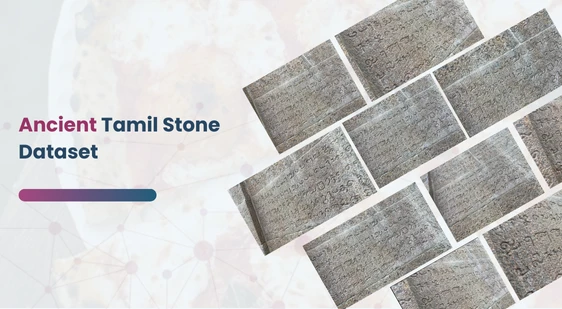Ancient Tamil Stone Dataset
Home » Dataset Download » Ancient Tamil Stone Dataset
Ancient Tamil Stone Dataset
Datasets
Ancient Tamil Stone Dataset
File
Ancient Tamil Stone Dataset
Use Case
Ancient Tamil Stone Dataset
Description
Explore the Ancient Tamil Stone Inscriptions Dataset featuring high-quality 3D models from the 1000-year-old Venkatesa Perumal Temple.

Description:
We are pleased to present a unique and valuable dataset collect from ancient stone inscriptions locate at the historic Venkatesa Perumal Temple in Kanchipuram, Tamil Nadu, India. The temple, which dates back over a millennium, is adorned with stone inscriptions that are equally ancient, offering insight into the language, culture, and history of the Tamil people. This dataset is a critical resource for those interest in studying Tamil epigraphy, paleography, and the preservation of heritage through 3D reconstruction techniques.
For each inscription, we have meticulously capture 15 to 25 digital images from multiple angles using high-resolution cameras. These images are utilize to reconstruct 3D models of the inscriptions, enabling a detail and comprehensive analysis. Additionally, we employed LiDAR technology to create high-accuracy 3D models, preserving these invaluable inscriptions in digital form for future generations.
Download Dataset
- Inscribed Inscriptions: These are inscriptions that remain intact and are carved deeply into the stone. They are relatively well-preserve and legible, providing clear information.
- Eroded Inscriptions: Over time, weathering has eroded parts of these inscriptions. While some characters may still be discernible, much of the original text has fade.
- Projected Inscriptions: These inscriptions are carved in such a way that the text projects outward from the stone surface. The unique style often makes them easier to read but also more susceptible to damage.
- Rural Paleographic Inscriptions: These inscriptions represent a specific style of writing used in rural areas. They often reflect the simpler, everyday language and script of the common people of the time.
- Urban Paleographic Inscriptions: In contrast, urban paleographic inscriptions were typically create in more sophisticate scripts. These were often commissioned by rulers or temple authorities and represent higher levels of literacy and formal language use.
3D Model Construction
The images capture for each inscription are use to construct 3D models of the stones, providing a digital preservation of these historical records. The number of input images plays a significant role in the clarity and detail of the final model. Our experiments show that with a minimum of 10 input images, a clear 3D model can be constructed. However, when 15-25 images are use, the resulting models are much sharper, offering greater detail and accuracy for further study and analysis.
The inclusion of LiDAR technology further enhances the accuracy of the 3D models by capturing intricate details in the inscriptions’ surfaces. This technology is especially useful for eroded or projected inscriptions, where traditional photography may struggle to capture the full depth and nuance of the text.
List of Inscriptions
- Inscription 1 – Eroded Inscriptions: Despite the wear and tear, some segments of the text are still visible, offering fragments of the original narrative.
- Inscription 2 – Urban Paleographic Inscriptions: Displaying the formal urban writing style, these inscriptions are a testament to the sophistication of the era’s linguistic and cultural practices.
- Inscription 3 – Projected Inscriptions: These inscriptions protrude from the surface of the stone, creating a unique visual experience and allowing easier identification of certain characters.
- Inscription 4 – Inscribed Inscriptions: These deeply carved inscriptions remain remarkably preserved, providing a clearer representation of the historical texts.
- Inscription 5 – Rural Paleographic Inscriptions: These inscriptions offer valuable insight into the language and script of rural Tamil Nadu, reflecting a simpler style.
- Inscription 6 – Eroded Inscriptions: As with Inscription 1, this inscription has suffered from the ravages of time, but still offers partial data for epigraphic studies.
This dataset is sourced from Kaggle.
Contact Us

Quality Data Creation

Guaranteed TAT

ISO 9001:2015, ISO/IEC 27001:2013 Certified

HIPAA Compliance

GDPR Compliance

Compliance and Security
Let's Discuss your Data collection Requirement With Us
To get a detailed estimation of requirements please reach us.
